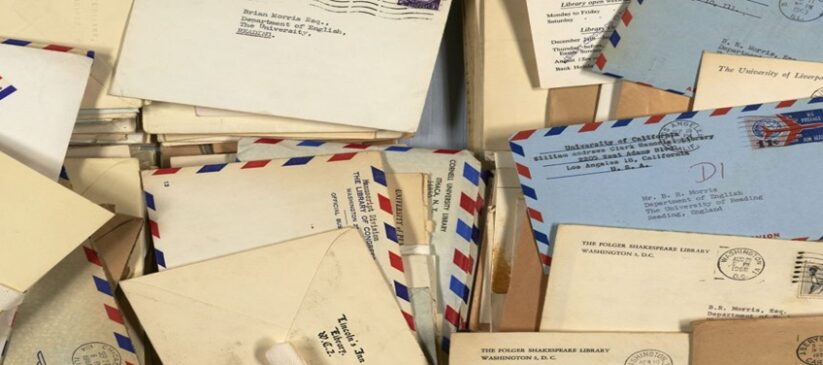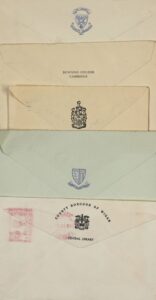A pile of old letters – new research methods, vintage limitations

Written by Amanda Knight, Graduate Trainee Archive Assistant, 2024-2025.
As the latest in a succession of Graduate Trainee Archive Assistants (GTAA) training with the University of Reading’s Museums and Collections team, I have been lucky to gain a wide range of hands-on experience whilst completing a postgraduate qualification in Archives & Records Management via Aberystwyth University’s distance learning programme. (I should add that not everyone does it this way around; plenty of GTAAs have completed a post like this before deciding whether to embark on further study/training required for a career in the sector).
As part of my role as a GTAA, I have been busy processing some previously uncatalogued papers including some donated to us by former students and staff. This has involved rehousing the materials into archival packaging and entering descriptions for them on our online catalogue Enterprise.
Amongst these uncatalogued items were two folders of papers accumulated by a former member of the University’s Faculty of Letters, ‘Dr B.R. Morris’ in the late 1950s to the early 1960s (MS 5741). At first pass, the contents seemed rather unassuming. However, on closer inspection, they led me to reflect on how academic research processes might have changed over the years. (They also neatly exemplified some of the theory I had recently learned whilst studying my course’s Rare Books module).
Dr B.R. Morris’ question
Brian Morris (1930-2001) graduated from Worcester College, Oxford in 1954, receiving his doctorate on the 17th century poet, satirist and staunch Royalist, John Cleveland, in 1963. Morris joined the University of Reading as a lecturer in English Literature (1958-1965) where he continued his research into Cleveland. This included the preparation of a bibliography of Cleveland’s poems which was published by the Bibliography Society in 1964.
The two folders making up MS 5741 contain Morris’ research for this bibliography, much of which having been based upon the entries found for Cleveland in Wing’s ‘Short Title Catalogue’. Morris had found Wing’s entries for Cleveland to be ‘not adequate’ for distinguishing between the 1647 and 1651 editions of his works and so Morris set about enlisting the help of the wider Rare Books community by writing to request details of Cleveland material held in their collections. His research notes record his aim of locating and examining 10 copies of each edition, ‘if 10 can be found’.
The Rare Books community’s response
The folders contain replies from more than 100 institutions. The replies came from universities, institutes and museums; from colleges, cathedrals, castles, clubs and corporations. They also came from libraries; from Wigan Public Library to the Library of Congress. More than 50 UK and 12 US universities and colleges, as well as 17 UK and 4 US libraries, and the national libraries of Austria, France, Germany and Ireland, all troubled to respond. There is even one from Donald Wing himself (then Associate Librarian at Yale)!
The letters date between 1955 and 1963 with Morris often needing to write to update earlier replies. The responses range in the level of detail; some are brief (even curt) but many more respondents were incredibly generous with their time, responding in considerable bibliographical detail. There is, however, one inexplicably testy reply which chastises Morris, replying, ‘May I suggest that in writing to strangers for information, you always enclose a “stamped envelope”’. Perhaps the correspondent at this particular college was affronted by Morris’ request because he notes (rather crossly) that the college library has ‘no old books’!
Bibliographic research, then and now
We can only imagine the campaign of letter-writing that must have been undertaken in order to elicit such a wide response. Were the letters of enquiry typed by Morris or did he employ an assistant for the task? Which directories were used to find names and addresses? The replies received come from a broader range of institutions than those listed for Cleveland in Wing.
Today, online union catalogues and bibliographies such as ESTC, World Cat, JISC Library Hub Discover and other e-resources would doubtless make for a quicker search to locate and differentiate between Rare Book editions. Other online tools exist to assist the researcher such as the Location Register or the searchable subject list on the Rare Books and Manuscripts Section of the ACRL website. A group email to the JISC Mail Rare Books list or a social media post amongst the Rare Book community could be done in a matter of minutes, undoubtedly written by the researcher themself. Replies can be researched and sent almost as quickly.
But while these modern research tools have undoubtedly improved access to resources and the speed of response, a familiar constraint still arises: an institution can only return results for what is already known and entered in its catalogue. This echoes some of the replies made to Morris nearly 70 years ago, many being sent with the proviso that they were responding, ‘as far as our catalogue goes’. A case of new research methods but vintage limitations.
Post-script: Lord Morris of Castle Morris 
Re-examining these papers has also afforded us the opportunity to reacquaint ourselves with a former member of our University’s community and his subsequent career.
After Reading, Morris went on to lecture at the University of York before being appointed as Professor of English Literature at the University of Sheffield and subsequently, as Principal of St David’s University College, Lampeter. At the same time, Morris was a regular contributor to and supporter of the arts and heritage sectors, holding numerous trusteeships and public posts including on the boards of the British Library and National Portrait Gallery. In 1990, he was granted a Life Peerage, where he acted as Labour’s deputy chief whip and spokesman for education in the House of Lords. The University of Sheffield has a collection of Morris’ papers which includes a detailed biography. Various other biographies of Lord Morris of Castle Morris, ‘poet, critic and professor of literature’ can be very easily found on the web – perhaps incongruously so, given the lengthy nature of his own intricate research process.
Sources
Morris, B.R. (1964) ‘The Editions of Cleveland’s Poems, 1647-1687’, The Library, Volume s5-XIX, Issue 1, 1964, pp 90–111).
Wing, D. G. (1945-1951) A short-title catalogue of books printed in England, Scotland, Ireland, Wales and British America and of English books printed in other countries 1641-1700. New York. Columbia University Press for The Index Society).